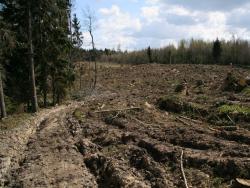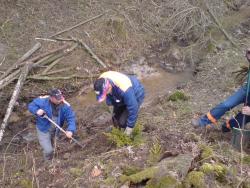 Asset Publisher
Asset Publisher
Polish forests
Poland is in the European lead, while concerning the area of all forests. They cover about 29,2 % of the country territory, and grow within the area of 9,1 million hectares. The overwhelming majority of the forests is state owned, of which almost 7,6 million hectares are managed by the State Forests National Forest Holding..
The number of Polish forest is still growing. The forestation rate of the country has increased from 21 % in 1945 to 29,2 % at the moment. Between 1995 and 2008, the forest area increased by 310 thousand ha. The basis for afforestation works is the "National Programme for Increasing the Forest Cover" (KPZL), assuming an increase of the forestation rate up to 30 % by 2020 and up to 33 % by 2050. Polish forests abound in flora, fauna and fungi. 65 % of the total number of animal species live there.
The forests grow in our country on poor soils, mainly because of the development of the agriculture in previous years. It influences the distribution of the types of the forest sites in Poland. Over 55 % of the forest areas is covered with coniferous forests. In other areas, there are forest sites, mainly the mixed ones. Their small part constitute alder and riparian forests – not more than 3 %.
In the years 1945 – 2011 the area of natural deciduous tree stands within the area of the State Forests National Forest Holding increased from 13 to 28,2 %.
Within the lowlands and uplands the most often occurring tee species is pine. It covers 64,3 % of the forest area of the State Forests National Forest Holding and 57,7 % of private and commune forests. In the mountains the predominant species is European spruce ( in the west) and European spruce with beech (in the east). Domination of pine is the result of carrying on sustainable forest management in the past. Once, the monocultures (crops or cultivations of one species) were the answer to the great demand of industry for wood. Such forests appeared to be quite fragile to climatic factors. They also were often the prey of pests' expansion.
In Polish forests, the share of other tree species, especially deciduous trees have been systematically increasing. The foresters have stepped aside from monocultures – that is why, they try to fit specific species of the forest stand to the natural stand, that would be proper for the given area. Thanks to that, in the years 1945 – 2011, the area of the deciduous tree stands within the lands of the State Forests National Forest Holding increased from 13 to 28,2 %. There occur more and more frequently the following tree species: oaks, ashes, maples, sycamore maples, elms, but also birches, beeches, alders, poplars, hornbeams, aspens, tilias and willows.
Our forests are the most often represented by the forest stands aged 40 to 80 years. The average age of the forest equals 60 years. More and more trees are of big size at the age over 80 years. Since the end of the Second World War, the forests' area has increased up to almost 1,85 million hectares.
Raport o stanie lasów w Polsce 2012
 Asset Publisher
Asset Publisher
 Asset Publisher
Asset Publisher
Hodowla lasu
Hodowla lasu
 Młode pokolenie lasu - uprawa leśna, fot. Anna Garackiewicz
Młode pokolenie lasu - uprawa leśna, fot. Anna Garackiewicz
 Dojrzała szyszka świerkowa, fot. Anna Garackiewicz.JPG
Dojrzała szyszka świerkowa, fot. Anna Garackiewicz.JPG
 Kontrola poprawnosci sadzenia, fot. Anna Garackiewicz.JPG
Kontrola poprawnosci sadzenia, fot. Anna Garackiewicz.JPG
 Leśne przedszkole - szkółka leśna, fot. Anna Garackiewicz.JPG
Leśne przedszkole - szkółka leśna, fot. Anna Garackiewicz.JPG
 Powierzchnia przygotowana do odnowienia, fot. Anna Garackiewicz.JPG
Powierzchnia przygotowana do odnowienia, fot. Anna Garackiewicz.JPG
 Sadzenie lasu na zboczu w tzw. talerze, fot. Michał Baranowski.JPG
Sadzenie lasu na zboczu w tzw. talerze, fot. Michał Baranowski.JPG
 Sadzenie lasu w trudnych warunkach, fot. Michał Baranowski.JPG
Sadzenie lasu w trudnych warunkach, fot. Michał Baranowski.JPG
Hodowla lasu to podstawowy dział leśnictwa. Jej zadaniem jest tworzenie nowych lasów (zalesienie) i zachowywanie i wzbogacanie istniejących (odnawianie i przebudowywanie) z uwzględnieniem wszystkich naturalnych warunków i czynników jakie zachodzą w środowisku leśnym.
Hodowla lasu oprócz zalesiania i odnawiania, to także produkcja sadzonek z nasion o udokumentowanym pochodzeniu, pielęgnacja upraw, wzbogacanie istniejących drzewostanów.
Hodowla lasu jest nauka leśna korzystającą z dorobku innych nauk przyrodniczych, miedzy innymi takich jak gleboznawstwo, klimatologia, botanika, fizjologia roślin .
Leśnicy wykorzystując wiedzę w zakresie hodowli lasu dążą do tego aby nowo powstałe lasy przy współudziale człowieka były jak najbardziej zbliżone do lasu naturalnego czyli takiego, w którym drzewostan jest dostosowany do siedliska, jest urozmaicony i przede wszystkim odporny. Aby powstał las, aby go posadzić trzeba wyhodować sadzonki. Miejscem produkcji sadzonek jest szkółka leśna. Sadzonki wysadzone do gruntu w sposób wcześniej ustalony to założenie uprawy leśnej. Uprawy poddawane są zabiegom pielęgnacyjnym i tak prowadzona jest hodowla aby docelowo uzyskać drzewostan dojrzały. Ostatnim etapem hodowli jest wycinka drzew dojrzałych, tak aby możliwe było ponowne odnowienie w optymalnych warunkach.
Nadleśnictwo Olecko aktywnie uczestniczy w Programie Zwiększania Lesistości Kraju po przez zalesianie gruntów nieprzydatnych gospodarce rolnej będących w zarządzie nadleśnictwa, są to najczęściej grunty bardzo niskich klas jakości. Sporządzamy również plany zalesień dla prywatnych właścicieli zalesiających grunty głównie w ramach Programu Rozwoju Obszarów Wiejskich (PROW).
Rocznie odnowienia w Nadleśnictwie Olecko obejmują około 220 ha.
Odnowienia czyli wprowadzenia lasu w miejscu, w którym rósł już wcześniej możemy dokonać na dwa sposoby. Sztucznie czyli sadzenie sadzonek lub wysianie nasion. Naturalnie, czyli przez samoistne obsianie się powierzchni i powstanie młodego pokolenia, najczęściej pod okapem drzewostanu, bez udziału człowieka. Do sadzenia potrzebujemy sadzonek.
Corocznie nasza szkółka leśna produkuje ok. 1,2 mln szt. sadzonek, głownie takich gatunków jak świerk, sosna, dąb, olsza, brzoza, modrzew i gatunki biocenotyczne czyli drzewa owocowe i krzewy.
Co roku pielęgnujemy ok. 800 ha gleby w uprawach leśnych. Czynność ta, polega przede wszystkim na wykaszaniu chwastów wokół sadzonek ale w starszych uprawach, a potem młodnikach wycinamy także młode drzewka. Chore, osłabione, źle ukształtowane lub takie, które szkodzą innym, bo są za bardzo wyrośnięte tzw. rozpieracze.
W zależności od wieku drzewek ciecia pielęgnacyjne nazywamy:
- Czyszczeniami wczesnymi - w okresie uprawy;
- Czyszczeniami późnymi – w okresie młodnika;
- Trzebieżami wczesnymi – w okresie dojrzewania drzewostanu;
- Trzebieżami późnymi – w okresie dojrzałości drzewostanu.
W Nadleśnictwie Olecko czyszczenia wczesne wykonujemy corocznie na obszarze ok. 160 ha, czyszczenia późne na 230 ha, trzebieże wczesne na 450 ha, a trzebieże późne na 600 ha.
Hodowanie lasu można porównać do hodowania marchewki. Tak samo trzeba wysiać, wyrywać chwasty czyli pielęgnować. Przerzedzać, bo jak jest za gęsta to ładna nie urośnie. Chronić przed chorobami. Różnica polega tylko na czasie oczekiwania na efekt.
Marchewka rośnie 1 sezon wegetacyjny, a las ok. 100 lat.


 fot. Paweł Fabijański
fot. Paweł Fabijański
 fot. Paweł Fabijański
fot. Paweł Fabijański
 fot. Paweł Fabijański
fot. Paweł Fabijański





